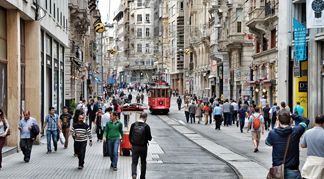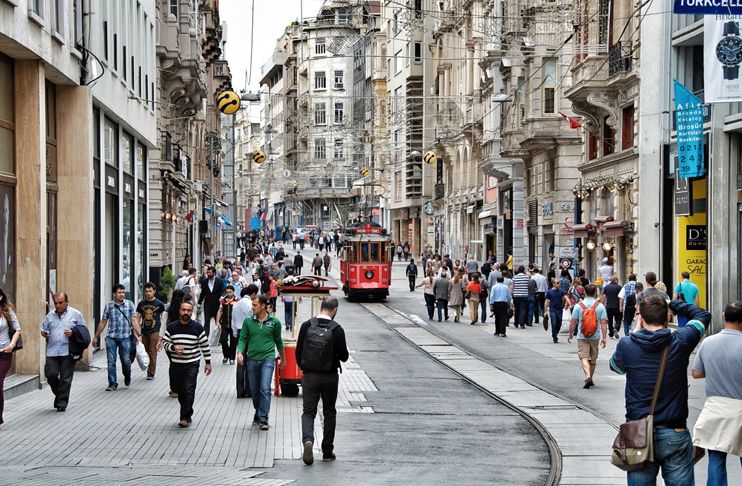
Defined as the most important spots of shopping life in Istanbul, Istiklal Street, Nişantaşı and Bağdat Street experienced a great deal of deprivation in 2016.
The third edition of Cushman & Wakefield’s Istanbul Shopping Streets report is published. In order to understand the retail market dynamics in Istanbul shopping streets, three main streets; Istiklal Street, Nişantaşı and Bağdat Street were chosen, indicator and parameters were analysed on a yearly basis. Retail stock, retail category difference in terms of national/international and garment/luxury brands, yearly renting volume, new retail accesses occurred in the last 12 months and street pedestrian traffic inventory are among these parameters.
According to the report, since September of 2016, the total retail stock in three main streets in 965 malls was around 195.000m2 and there has been a decline in number of malls compared to the last two years. A decrease occurred in the number of malls because of urban renewal activities condensed especially in Nişantaşı and Bağdat street and building destructions.
Still having the highest rate with 35%, in terms of the sector distribution of retailers; garment, shoes and bags category was followed by food & beverage with 18% and accessories-cosmetics sectors with 16%. However, the slight mall numbers decrease in food & beverage sectors made the inclination continuing for three years clear. Similarly, just like the last 2 years, the number of both international and luxury brands went on declining on main streets.
The number of international brands regressed from 173 to 140 between 2014 and 2016. On the basis of international brand number, Nişantaşı region ranked in the first place with 64 stores where Bağdat Street with 48 and Istiklal Street took the last place with 28 stores. With the opening of high-end shopping malls such as Istinye Park and Zorlu Center in European side, Akasya Acıbadem and Emaar Square in Anatolian side, the location of luxury brands became varied and widespread.
Between the range of September 2015-2016 the number of brand stores on these three main streets regressed from 27 to 21 apart from the branch banks and GSM stores. The brands opening their second store on the same street with aggressive growth strategy went downsizing. Garment, accessories and cosmetic and food & beverage brands addressing especially to medium income groups are located on all these places.
International Brands Made A Significant Egress
Despite the consolidations and egresses, the user market in 105 stores stood relatively active in the last 12 months with total 16.000m2 renting operations. The most renting operations occurred in Bağdat Street with 40% rate. 42% of total renting operations were garment, shoe and bag brands. Even though %74 of the renting operations were new entries; the majority of them consisted of small scaled local or national brands. Only 15% of total renting operations were performed by international brands.
2016 growth of big garment, food & beverage and cosmetic brands opening 31 new stores in 2015 was only limited with 13 stores. In the last 12 months, while 67 new brands came to the main street, 95 brands went out. In terms of the size of the stores; new renting operations were mostly made in small (smaller than 50m2) and medium size(between 100-200m2) stores. 80% of total operations included stores smaller than 200m2.
In the last 4 years, general emptiness rate showed a tendency to increase. The general emptiness rate which was 5% in September 2013 rose up to 15% in September 2016. Both the number and total free space of the empty stores increased. Bağdat Street was affected by this tendency very seriously.
Descending Visitor Number Affected Stores Negatively
On Istiklal street having total retail stock of 62. 500m2 in 253 stores, the number of international brands went down from 35 to 28 in the last two years. Despite the egress of 5 international and 12 food & beverage brands on the street whose visitor number decreased to 12%, new entries were performed mostly by national brands.
In Nişantaşı region, the total stock in 380 stores is around 58.500 m2. In addition to luxury brands, both national and international garment brands and restaurants addressing to high-end segment as well as food & beverage places come to the forefront. There are 64 international brands in Nişantaşı. Additionally, both national and international 75 luxury and accessible luxury brands’ stores are located in the region. 11 out of 40 brands that went out from the region in September 2015-2016 period, are international.
On Bağdat Street; whose total stock went down to 75.000 m2 in 332 stores; 43 brands egressed in the last 12 months. After the serious decline on this street; since September 2016 there are 48 international and 35 luxury brands on the street.
In the report that takes fluctuations in exchange rate, economical oppressions and security worries into consideration; it is stated that the fragility on main streets would relatively continue.


